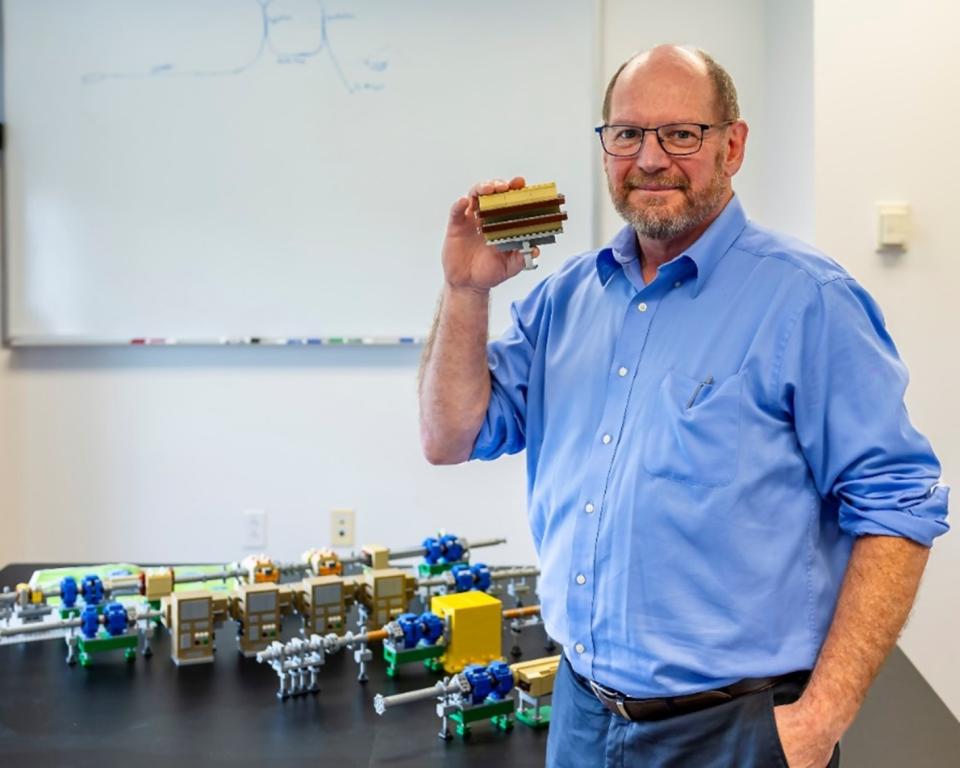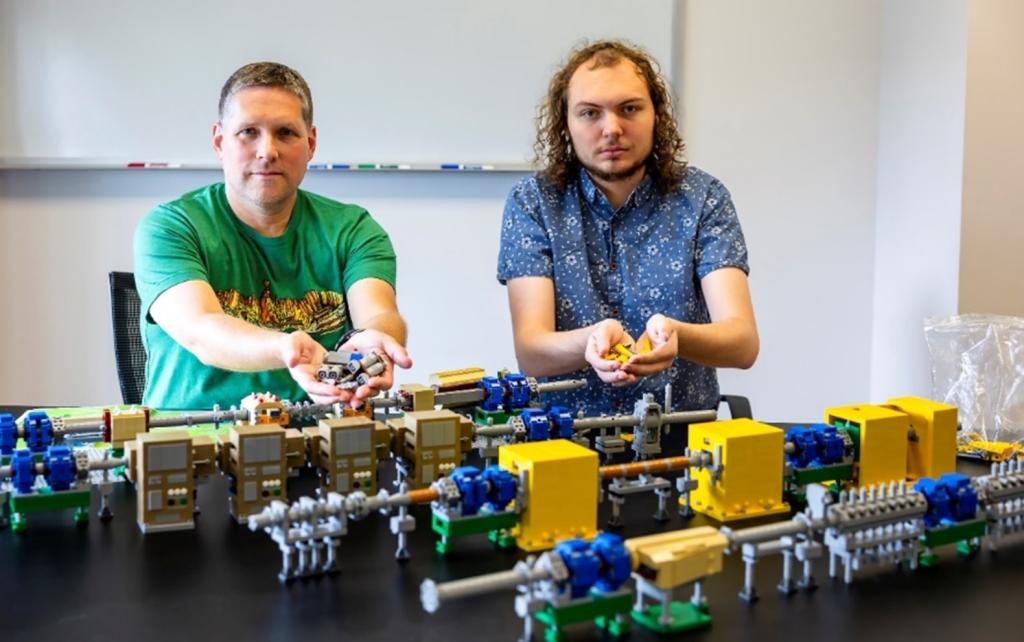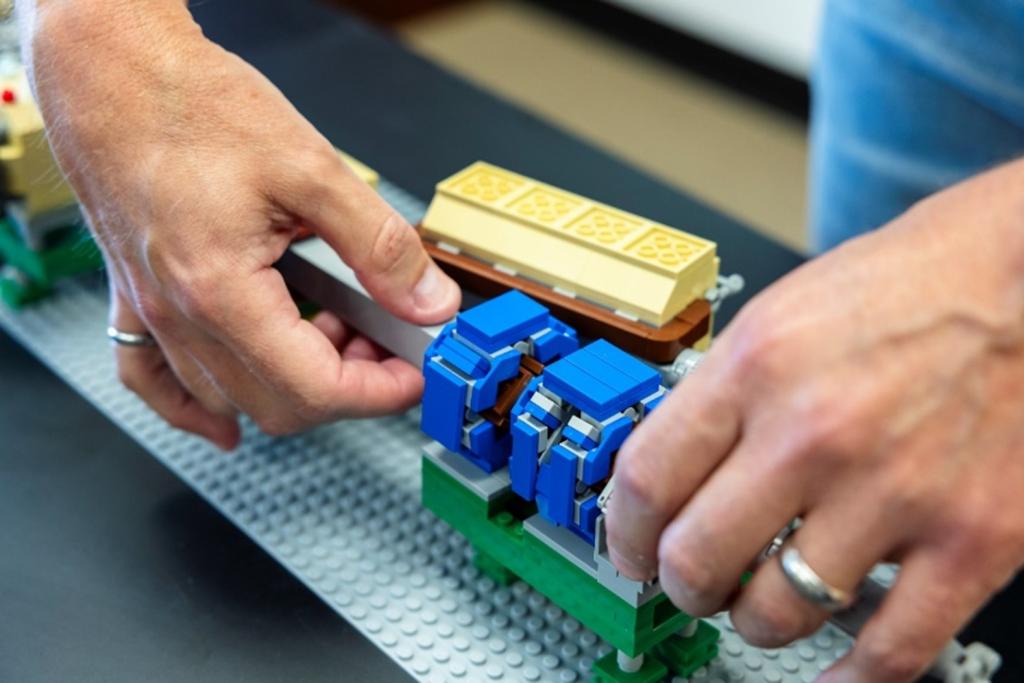
Oak Ridge National Laboratory's Spallation Neutron Source, or SNS, is a pulsed accelerator that produces neutrons for science, bringing researchers from all over the world to conduct experiments to gain insights across a wide range of fields including biology, materials and energy sciences, physics, engineering and chemistry.
To say the accelerator is a highly complex piece of equipment is an understatement. At an impressive three football fields long, the SNS requires a team of engineers, technicians and specialists who keep it operating safely and reliably.
Robert Saethre, Asset Management and Engineering Program Manager for the Neutron Sciences Directorate at ORNL, intends for students to build the accelerator with LEGO® bricks, albeit a much, much smaller version. Aimed to be both fun and challenging, this pilot program for the model accelerator - appropriately called the "SNS LEGO Model Middle School Outreach Program" - is Saethre's way to introduce more middle schoolers to science, technology, engineering and math, or STEM.
Participating students will use LEGO bricks to construct a scaled model of the accelerator, gaining a hands-on understanding of the SNS design and operational principles. This initiative not only introduces students to the workings of the lab but also plays a crucial role in workforce development, equipping them with valuable skills for the future.
"Our goal is to give students an interactive experience that will spark their interest in STEM," said Saethre. "This program will provide an incredible opportunity to introduce students to the SNS and how it operates, and in doing so they will learn about the many jobs offered here at the lab."
The purpose of the pilot program is to bring in middle school students from up to a dozen schools across East Tennessee. Saethre partnered with Macy Eason, a middle school teacher at Cherokee Middle School, who developed a curriculum for the program. Over the summer, Eason created a lesson plan and interviewed ORNL employees at the SNS to craft job descriptions in a language that middle schoolers can better understand. The idea is to introduce students to the many career opportunities available at the lab and motivate them to pursue STEM courses so that they may one day be in a similar role.

"I believe this program will be fun and engaging for the students," said Eason, who is most excited about reaching children who may not be interested in STEM or think a career at the lab is unachievable. "I hope this program continues year after year and grows to include many schools in the area. It is such a great opportunity for local students, and for ORNL."
The program is intended to span the course of three class periods over three consecutive days. Students will learn about the SNS and how a linear accelerator works using a ping pong ball particle accelerator model. They will work in pairs to construct components of the SNS's injection region using custom LEGO kits and discover many different career opportunities at the SNS comparing fields of interest, education requirements plus benefits and approximate compensation for these types of positions.
In addition to the three-day program, Saethre has organized a STEM Day, where participating schools will be invited to the SNS to tour the facility, speak with employees and combine their LEGO components to form the complete SNS accelerator LEGO model.
Building the idea
Saethre first got the idea while attending the Linac 2022 Conference in Liverpool, United Kingdom, where there was a raffle for a LEGO model of the Large Hadron Collider. This unique application using popular toy blocks inspired Saethre to bring the concept back to Oak Ridge with the intent to teach children about STEM-related career paths using familiar materials. Once he'd returned from the conference, Saethre quickly got to work bringing his vision to life.
The first step was ensuring that constructing the SNS accelerator using LEGO bricks was possible. Thanks to the work of ORNL intern Stauffer Randa, a mechanical engineering student at the University of Tennessee, Knoxville, the hands-on portion of the outreach program began building.
Randa, who has spent his past two summers interning at ORNL working on the project, started by developing a scale model of the SNS chicane magnet region where the hydrogen ions are injected into the accelerator ring. The real SNS accelerator ring is 271 yards long, and protons spin around it about 1,000 times in less than one-millionth of a second. The LEGO build is currently projected to be a 1/20th scale model, so approximately 15 feet in diameter.

With guidance from his supervisor, mechanical engineer Chad Helland, Randa used 2,091 LEGO bricks to construct the approximately 3-foot-long model. The project involved scaling the existing three-dimensional computer-aided design models of the linac and accumulator to a size that made sense to build while also providing the desired amount of detail.
"I look forward to young people being inspired to work in STEM, whether that be physicists, engineers or mathematicians," said Randa.
Helland looks forward to using the model for educational outreach. "Middle school is often when students are being introduced to different career paths. My hope for this program is that it inspires kids to pursue jobs in engineering and science."
The SNS LEGO Model Middle School Outreach Program aims to inspire the next generation of scientists and engineers by providing an immersive and educational experience. The program is expected to launch next spring following the completion of the Tennessee Comprehensive Assessment Program.
SNS is a Department of Energy Office of Science user facility.
UT-Battelle manages ORNL for DOE's Office of Science, the single largest supporter of basic research in the physical sciences in the United States. The Office of Science is working to address some of the most pressing challenges of our time. For more information, please visit energy.gov/science - Kaeli Swaggerty.






